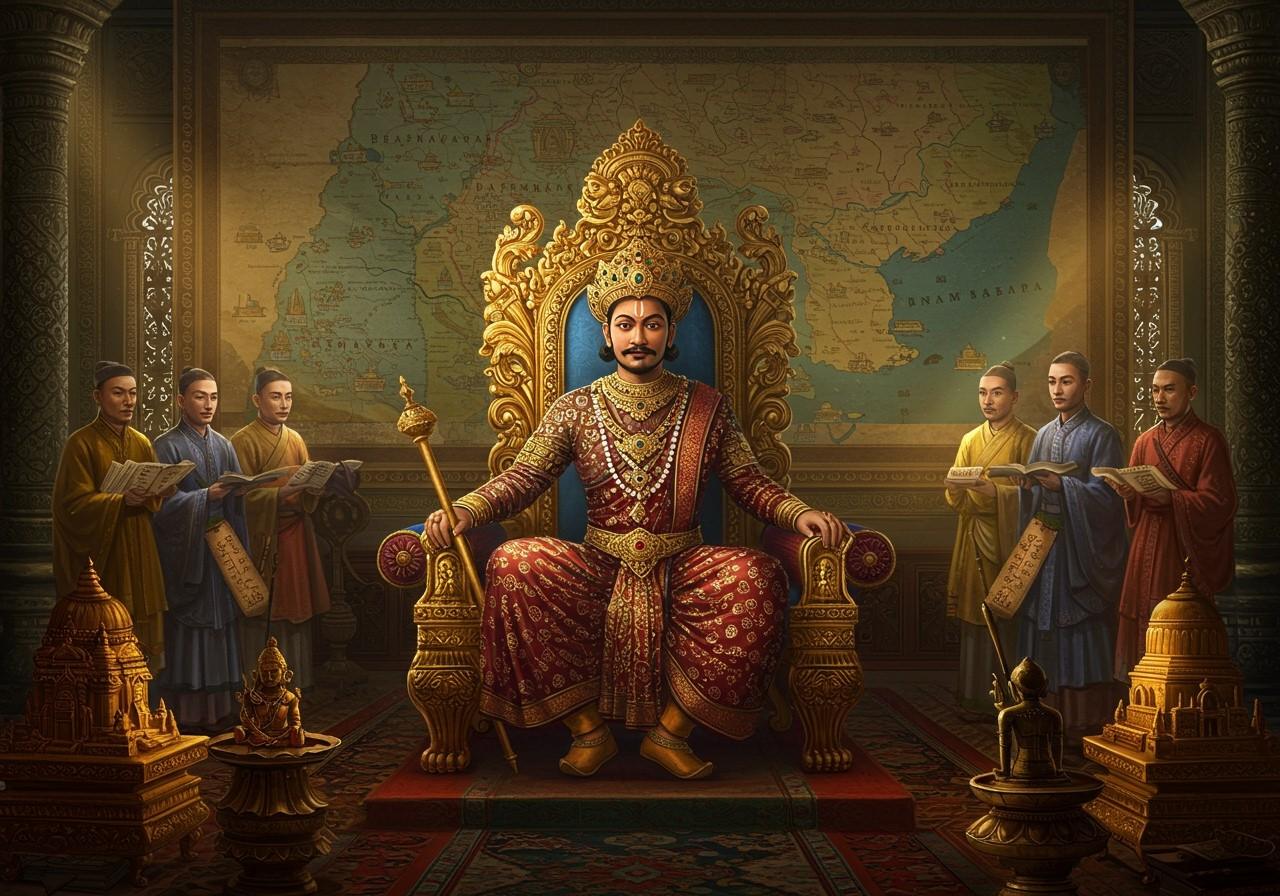
Bhaskar Varman’s reign (circa 600-650 AD) marks a pivotal chapter in ancient Assam’s history. As a prominent ruler of the Varman dynasty, his 50-year reign is celebrated as a golden age, marked by significant advancements in culture, politics, and trade. Though his story isn’t widely known in mainstream Indian history, his fame resonates in ancient texts like Banabhatta’s Harshacharita and the travelogues of Chinese pilgrim Xuanzang (Hiuen Tsang). These accounts paint a picture of a learned king, a devout Hindu ruling over a people described as having a yellow complexion and short stature.
The Varman Dynasty: Setting the Stage
The Varman dynasty, which held sway over Kamarupa (present-day Assam), emerged around the 4th century AD with Pushyavarman at its helm. This dynasty played a crucial role in consolidating power and maintaining regional autonomy against larger empires like the Guptas. The political landscape was constantly shifting, with neighboring kingdoms rising and falling, creating a complex backdrop for the events that unfolded.
- Pushyavarman: The founder of the dynasty, Pushyavarman laid the groundwork for future rulers, establishing a foundation upon which the kingdom could grow and prosper. His reign marked the beginning of a new era in Assam’s history.
- Samudravarman: Further strengthening the kingdom, Samudravarman fiercely resisted external control, particularly from the encroaching Gupta Empire. His efforts were critical in preserving Kamarupa’s independence during a period of significant regional upheaval.
Bhaskar Varman’s Rise and Rule
Bhaskar Varman ascended to the throne in the early 7th century AD, succeeding his father, Bhuti Varman. His early reign was fraught with challenges, including internal dissent and external pressures. However, strategic alliances and astute administrative reforms became the cornerstones of his success.
- Alliance with Emperor Harshavardhana: A pivotal partnership with Emperor Harshavardhana of Kanauj significantly strengthened Bhaskar Varman’s position. This alliance provided mutual military support and fostered cultural exchange, shaping the political dynamics of northern India. It is believed that Bhaskar Varman and Harshavardhana shared a deep respect for each other.
- Administrative Reforms: Bhaskar Varman implemented key administrative policies that stabilized and strengthened his kingdom. These reforms fostered political stability and created an environment conducive to cultural growth and economic prosperity throughout Kamarupa.
Diplomacy and Military Might
Renowned for his diplomatic acumen and military prowess, Bhaskar Varman skillfully navigated the complex political landscape. His alliance with Harshavardhana stands as a testament to his strategic thinking, while his military campaigns secured Kamarupa’s borders and expanded its influence.
- Nature of the Alliance: The alliance with Harshavardhana wasn’t merely a military pact; it fostered cultural exchanges and intellectual discourse, enriching both kingdoms. This partnership played a crucial role in maintaining peace and stability in northern India.
- Military Campaigns: Bhaskar Varman led successful military campaigns that not only defended Kamarupa’s borders but also expanded its territories. These strategic victories further enhanced the kingdom’s stability and prosperity, solidifying his reputation as a strong and capable leader.
A Flourishing of Culture and Economy
Bhaskar Varman’s reign witnessed a remarkable flourishing of culture and economic development. He was a patron of the arts, literature, and religion, fostering an environment of intellectual and artistic growth.
- Cultural Contributions: A staunch supporter of Sanskrit literature, Bhaskar Varman patronized scholars and artists, contributing to a vibrant cultural scene. His reign is considered a high point for intellectual and artistic pursuits in Kamarupa.
- Economic Policies: Wise economic policies encouraged trade and commerce, leading to increased prosperity within the kingdom. This focus on economic growth further solidified Kamarupa’s position as a regional power.
A Legacy of Prosperity and Cultural Enrichment
Bhaskar Varman’s reign left an enduring legacy on Assam. His diplomatic achievements, military successes, and patronage of the arts shaped the region’s trajectory for centuries to come. His era is remembered as a golden age, a period of stability, prosperity, and cultural efflorescence.
- Political Stability: Bhaskar Varman’s rule ensured a long period of political stability, allowing the kingdom to flourish without constant internal strife or external threats. This stability was a key factor in the overall growth and prosperity of Kamarupa during his reign.
- Diplomatic Influence: His diplomatic strategies, particularly the alliance with Harshavardhana, set a precedent for future regional interactions and alliances. His approach to diplomacy influenced subsequent rulers and shaped the political landscape of the region.
- Cultural Significance: Bhaskar Varman’s patronage of art, literature, and religion left an indelible mark on Assam’s cultural heritage. His support for these fields fostered a vibrant cultural scene that continued to influence the region long after his reign.
Connecting to Assam’s Heritage with Poojn.in
At Poojn.in, we offer a curated selection of puja items that help you connect with India’s rich spiritual traditions, reminiscent of the era of kings like Bhaskar Varman. Explore our collection:
Pure copper and brass items for daily worship, Traditional bell-metal utensils, Authentic dhoop and incense and Sacred threads and religious accessories.
We ensure secure, pan-India delivery, preserving the sanctity of these sacred items. Experience the devotion and reverence of our ancestors with Poojn.in.
FAQs: Delving Deeper into Bhaskar Varman’s Reign
Was Bhaskar Varman the most significant ruler of the Varman dynasty? Many historians consider Bhaskar Varman the greatest of the Varman kings due to his impactful reign, marked by political prowess and diplomatic achievements.
Did Bhaskar Varman rule during the time of Samudragupta? It’s important to note that Bhaskar Varman reigned centuries after Samudragupta. The Gupta emperor reigned from approximately 335 to 380 AD, while Bhaskar Varman’s reign was around 600-650 AD.
What were Bhaskar Varman’s key accomplishments? Bhaskar Varman’s notable achievements include territorial expansion through strategic alliances and military victories, fostering cultural and educational advancements, and maintaining a long period of peace and stability.
Conclusion
Bhaskar Varman’s reign stands as a testament to effective governance, strategic alliances, and cultural patronage. His legacy continues to inspire, reflecting a golden era in Assam’s history, marked by prosperity and cultural flourishing.
Explore more about Assam’s spiritual heritage: Dhekiakhowa Bornamghar, Assam’s Sacred Sites.


